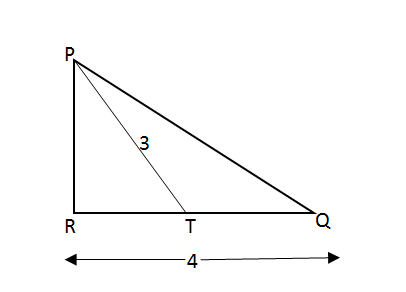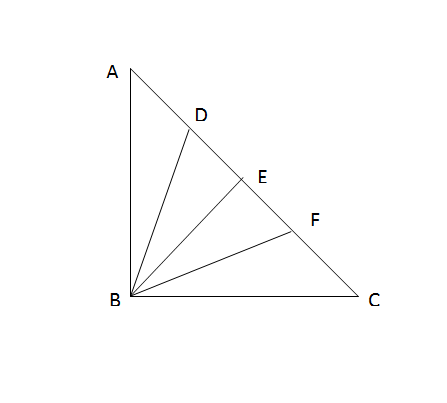First, here’s the general 3-step process for any quant problem, geometry included:

All geometry problems also have three standard strategies that fit into that process.
First, pick up your pen and start drawing! If they give you a diagram, redraw it on your scrap paper. If they don’t (as in the above problem), draw yourself a diagram anyway. This is part of your Glance-Read-Jot step.
Second, identify the “wanted” element and mark this element on your diagram. You’ll do this as part of the Glance-Read-Jot step, but do it last so that it leads you into the Reflect-Organize stage. Where am I trying to go? How can I get there?
Third, start Working! Infer from the given information. Geometry on the CAT can be a bit like the proofs that we learned to do in school. You’re given a couple of pieces of info to start and you have to figure out the 4 or 5 steps that will get you over to the answer, or what you’re trying to “prove.”
Here is how you can solve geometry step by step. Try this problem-
A right angled triangle PQR is such that ∠PRQ = 90° and QR = 4 cm T is a point on QR such that PT = 3 cm, and perimeter of triangle PQT = Perimeter of triangle PTR Then, QT/TR>2 takes the value.
a)QT/TR<13
b)13<QT/TR<1
c)QT/TR>1
d)can’t be determined
Solution:

In the figure,
Given P (∆PRT) = P (∆PTQ)
=) PR + RT + PT = PT + TQ + PQ
=) PR + RT = QT + PQ
Since, PQ > PR (PQ is hypotenuse)
=) RT > OT
=)QTTR>1
Also, given PT = 3 so RT <3 (PT is hypotenuse)
Since, RT+ TQ = 4, when RT = 3, TQ = 1
But Since RT <3 ∴ QTTR>13
∴ b) Answer
Here, in the above question, the first step was to draw the diagram to get your head clear and it makes it easier for you to identify which theorem or formula can be used to solve this sum.
Once you have drawn and made the picture a little bit clearer, the given information should be used to infer what exactly is the way to solve the problem. This given information is nothing but a hint or the key for you to solve the sum, sometimes certain questions may carry unnecessary information though.
In the above question,triangle PQR is a right angled triangle, so The Pythagoras theorem should be the first thing to enter your mind. You may not use it in the sum, but it will help you determine that PQ>QR and PT>RT (step 3 and 7)
Similarly the perimeters of both the triangles are equal.This should help you hit that there is an equation that can be created. These two were the major steps inferred from the given data that should help you solve the problem. The key to geometry is not the information itself, but how to use that information in finding the answer.
Beginners can try this- Initially when you start solving a Geometry sum, Take a look at the given information and note down the theorems and formulas that you can use with it, if you are not able to recollect exactly which one to use. This is slow and unrequited process,but it should definitely help.
Here is another sum for your practice.

In the above figure, ΔABC is right angled and AC = 100 cm. Also, AD = DE = EF = FC. Find the value of:
BD2 + BE2 + BF2 (in cm2)
- 10,000
- 5,000
- 8,750
- 12500
Solution:
E is the midpoint of hypotenuse AC so, BE =
12∗AC=50 cm
Now, applying Apollonius’s theorem on ΔABE
=) AB
2 + BE
2 = 2 x (BD
2 + AD
2)
=) AB
2 + 50
2 = 2 x (BD
2 + 25
2)……….(1) (As, AD = DE = EF = FC = 25 cm)
Similarly, in ΔBEC,
=) BC
2 + BE
2 = 2 x (BF
2 + EF
2)
=) BC
2 + 50
2 = 2 x (BF
2 + 25
2)………..(2)
Adding (1) and (2),
=) AB
2 + BC
2 + 2 x 50
2 = 2 x (BD
2 + BF
2 + 2 x 25
2)
=) AC
2 + 2 x 50
2 = 2 x (BD
2 + BF
2) + 4 x 25
2 (As, AB
2 + BC
2 = AC
2)
=) 100
2 + 2 X 50
2 – 50
2 = 2 x (BD
2 + BF
2)
=) 100
2+ 50
2 = 2 x (BD
2 + BF
2)
=)
(10,000+2,500)2=BD2+BF2=6250
=) BD
2 + BF
2 + BE
2 = 6250 + 50
2 = 6250 + 2500 = 8750 cm
2
Correct Answer: 8,750
cat geometry concepts
geometry for cat pdf
geometry questions for cat pdf
cat questions on triangles
cat geometry tricks
cat geometry previous year questions
circle questions for cat
cat geometry formulas
 All geometry problems also have three standard strategies that fit into that process.
First, pick up your pen and start drawing! If they give you a diagram, redraw it on your scrap paper. If they don’t (as in the above problem), draw yourself a diagram anyway. This is part of your Glance-Read-Jot step.
Second, identify the “wanted” element and mark this element on your diagram. You’ll do this as part of the Glance-Read-Jot step, but do it last so that it leads you into the Reflect-Organize stage. Where am I trying to go? How can I get there?
Third, start Working! Infer from the given information. Geometry on the CAT can be a bit like the proofs that we learned to do in school. You’re given a couple of pieces of info to start and you have to figure out the 4 or 5 steps that will get you over to the answer, or what you’re trying to “prove.”
Here is how you can solve geometry step by step. Try this problem-
A right angled triangle PQR is such that ∠PRQ = 90° and QR = 4 cm T is a point on QR such that PT = 3 cm, and perimeter of triangle PQT = Perimeter of triangle PTR Then, QT/TR>2 takes the value.
a)QT/TR<13
b)13<QT/TR<1
c)QT/TR>1
d)can’t be determined
Solution:
All geometry problems also have three standard strategies that fit into that process.
First, pick up your pen and start drawing! If they give you a diagram, redraw it on your scrap paper. If they don’t (as in the above problem), draw yourself a diagram anyway. This is part of your Glance-Read-Jot step.
Second, identify the “wanted” element and mark this element on your diagram. You’ll do this as part of the Glance-Read-Jot step, but do it last so that it leads you into the Reflect-Organize stage. Where am I trying to go? How can I get there?
Third, start Working! Infer from the given information. Geometry on the CAT can be a bit like the proofs that we learned to do in school. You’re given a couple of pieces of info to start and you have to figure out the 4 or 5 steps that will get you over to the answer, or what you’re trying to “prove.”
Here is how you can solve geometry step by step. Try this problem-
A right angled triangle PQR is such that ∠PRQ = 90° and QR = 4 cm T is a point on QR such that PT = 3 cm, and perimeter of triangle PQT = Perimeter of triangle PTR Then, QT/TR>2 takes the value.
a)QT/TR<13
b)13<QT/TR<1
c)QT/TR>1
d)can’t be determined
Solution:

